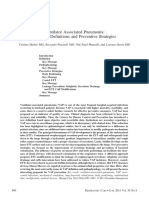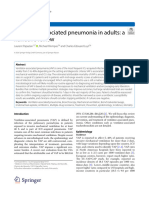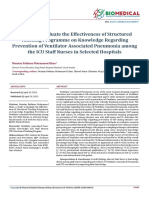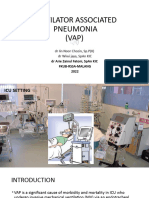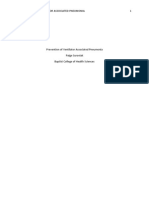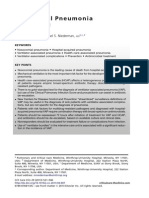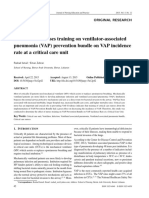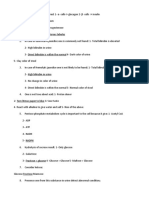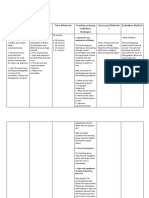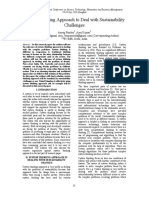THESIS PROTOCOL
TITLE: A prospective study on efficacy of education and
implementation of ventilator associated
pneumonia (VAP) prevention bundle on incidence
of VAP in a medical intensive care unit (MICU) at
a tertiary care teaching hospital
NAME OF THE CANDIDATE: Dr MANOJ KOLLIPARA
DEGREE FOR WHICH REGISTERED: MD (MEDICINE)
YEAR OF JOINING: 2022
CHIEF-GUIDE: Dr J. HARI KRISHNA
Professor and HOD
Department of Medicine
Sri Venkateswara Institute of Medical Sciences
Tirupati 517507
CO-GUIDES: Dr ALLADI MOHAN
Dean, Professor (Senior Grade)
Department of Medicine
Sri Venkateswara Institute of Medical Sciences
Tirupati 517507
Dr K. CHANDRA SEKHAR
Assistant professor
Department of Medicine
Sri Venkateswara Institute of Medical Sciences
Tirupati 517507
1
�Dr C.V.S MANASA
Assistant professor
Department of Medicine
Sri Venkateswara Institute of Medical Sciences
Tirupati 517507
Dr N. RAMA KRISHNA
Assistant professor
Department of Microbiology
Sri Venkateswara Institute of Medical Sciences
Tirupati 517507
2
� INTRODUCTION
Ventilator associated pneumonia (VAP) is defined as a pneumonia where the patient is
on mechanical ventilation for > 2 consecutive calendar days on the date of event, with
day of ventilator placement being day 1, and the ventilator was in place on the date of
event or the day before (1). Despite advances in the microbiological tools &
diagnostic criteria for VAP still remain controversial thus complicating the treatment,
prevention & outcome thereby posing a significant economic burden. The incidence of
VAP varies from 2.13 to 116 per thousand days, in different countries of south east
Asian region among patients requiring invasive mechanical ventilation for more than 2
days hence the incidence largely varies depending upon the country, ICU type and the
diagnostic criteria used to identify VAP (2).
The Institute of Healthcare Improvement (IHI) advocated the use of “Ventilator
Associated Pneumonia (VAP) Bundles of Care” to decrease morbidity & mortality in
patients with VAP. “Care bundle” include a set of measures which are evidence based
and when implemented together has shown to produce better outcomes. IHI estimates
that over 122,000 lives have been saved, with decreased days of mechanical
ventilation & hospital stay, through this bundle care initiative. The aim of care bundles
is to improve the health outcomes by facilitating and promoting changes in patient
care & to encourage guideline compliance (3). More than 95% compliance rate with
the VAP bundle is often required to achieve zero incidence of VAP, but however to
date there were no reports of sustained low incidence of VAP (4). Periodic assessment
of the health care personnel i.e, medical & nursing staff is often recommended to
improve long-term compliance (5).
Current VAP prevention bundle includes elevation of head end of the Bed to 30 O,
Daily sedative interruption and daily assessment of readiness to get extubated, peptic
ulcer disease (PUD) Prophylaxis, deep vein thrombosis (DVT) Prophylaxis and Daily
Oral Care with Chlorhexidine as components has been adopted by various bodies like
National Institute for Health and Care Excellence (NICE) and IHI. Some of the
components of this bundle are controversial. Studies on gastric stress ulcer
3
�prophylaxis has shown that it reduces the gastro intestinal bleeding, but has no impact
on incidence of VAP. In fact, in patients receiving enteral nutrition it may increase the
risk of pneumonia. Another controversial component is oral care with chlorhexidine.
Studies have shown that oral chlorhexidine is more beneficial in prevention of VAP in
cardiac surgery patients. In non-cardiac surgery patient’s the evidence is equivocal.
Another component is DVT prophylaxis, which has no direct role in prevention of
VAP. In view of these shortcomings of some of the components of the existing bundle
NICE has withdrawn VAP prevention recommendations.
Due to the limitations of the existing VAP prevention bundle and identification of
other potential strategies for prevention of VAP, present study was designed to
determine the effect of education and implementation of new VAP care bundle on
incidence of VAP at our tertiary care teaching hospital.
4
� REVIEW OF LITERATURE
DEFINITION
Ventilator associated pneumonia (VAP), is the most common & fatal nosocomial
infection of critical care, which is a new onset pneumonia that develops after 48 hours
of endotracheal intubation.
Patients with VAP suffer a longer hospital stay & incur higher healthcare costs than
similarly ill patients without VAP.
While scoring systems such as the Clinical Pulmonary Infection Score are used to
guide the management of community-acquired pneumonia (CAP), the Infectious
Diseases Society of America (IDSA)/American Thoracic Society (ATS) guidelines
suggest using clinical criteria for the management of VAP.
According to the guidelines, the diagnosis of VAP requires all of the following:
1. New lung infiltrates on chest imaging.
2. Respiratory decline.
3. Fever.
4. Productive cough.
Absence of a new infiltrates significantly lowers the probability of VAP & can guide
the clinician to alternative causes of inpatient respiratory decline (6).
RISK FACTORS FOR DEVELOPMENT OF VAP
Several risk factors predispose to the development of VAP. In order to improve the
outcome of patients with mechanical ventilation and to reduce the incidence of VAP it
is necessary to delineate the risk factors of VAP for control & clinical prevention of
VAP.
Thirteen potential risk factors have been identified for the development of VAP as
shown in Table 1(7).
5
� Table 1: Risk factors of VAP
Advanced age
Male gender
Increased mechanical ventilation time
Prolonged length of hospital stay
Disorders of consciousness
Burns
Comorbidities
Prior antibiotic therapy
Invasive operations
Gene polymorphisms
Smoking
Intra- abdominal Hypertension
Hyperoxemia
VAP= ventilator associated pneumonia
EPIDEMIOLOGY
Approximately 1/3rd of nosocomial pneumonias are acquired in the ICU, with VAP
being the majority of those cases. VAP rates in North America have been reported to
be as low as 1–2.5 cases per 1000 ventilator-days (8). However, European centres
report much higher rates. The EU-VAP/CAP study has reported an incidence density
of 18.3 VAP episodes per 1000 ventilator-days (9). While lower–middle-income
countries have also reported higher rates compared to US hospitals & other high-
income countries in particular (18.5 vs 9.0 per 1000 ventilator-days; P = .035) (10).
These large discrepancies can be explained by differences in definitions & their
application, diagnostic limitations of all definitions & differences in microbiological
sampling methods (11). The daily risk of VAP peaks between 5–9 days of mechanical
ventilation, while the cumulative incidence is related to the total duration of
mechanical ventilation (12). The most important risk factor for VAP is likely the
underlying medical conditions of mechanically ventilated patients including their
comorbidities & severity of illness. Likewise the increased incidence observed in
chronic obstructive pulmonary disease (COPD) patients might be explained by
prolonged duration of MV support (due to muscular weakness), high incidence of
micro aspiration and bacterial colonization (as a result of defective mucociliary
clearance), altered local and general host defence mechanisms (13).
6
�MORBIDITY & MORTALITY
VAP increases health care expenses & prolongs the duration of both mechanical
ventilation & ICU stay worsening the financial burden & state of health. Whereas
mortality is predominantly driven by patient’s underlying conditions and illness
severity. The all-cause mortality associated with VAP has been reported to be as high
as 50%, while there is still considerable controversy regarding the extent to which
VAP contributes to death in ICU patients (2). Attributable VAP mortality has been
defined as the percentage of deaths that would not have occurred in the absence of
infection. A risk survival analysis, treating ICU discharge as a competing risk of ICU
mortality among 4479 patients treated in French ICUs, reported that ICU mortality
attributed to VAP was very low, about 1% on day 30 & 1.5% on day 60 (14).
PATHOGENESIS
The pathogenesis of VAP mainly occurs by the introduction of microbial pathogens
through micro aspiration beyond the tracheal tube cuff into the lower respiratory tract.
The various host defence mechanisms such as humoral, mechanical and cellular
defence mechanisms subsequently lead to the development of VAP. Furthermore, the
use of sedation also leads to the suppression of cough reflex resulting in hampering of
natural reflexes. The complex interaction between endotracheal tube, virulence of
invading organism, presence of risk factors and host immunity determine the
development of VAP. Most important risk factor among all the factors is the presence
of an endotracheal tube itself which results in violation of natural defence mechanisms
(cough reflex of glottis and larynx) against micro aspiration around the cuff of the
tube. Though endotracheal tube can prevent gross aspiration, it cannot provide a
perfect sealing because there is presence of folds along the surface of the cuff which
comes in contact with the trachea, improper inflation and movements and
subsequently leading to pooling of oropharyngeal secretions upon the cuff and leak
through. The presence of endotracheal tube cuff impairs the mucociliary function and
mucociliary velocity is decreased to less than half after 2 hours of intubation which
creates mechanical obstacle to clearance of mucus. Improper suctioning results in
accumulation of mucus near the endotracheal tube opening, or mucus can reverse its
flow and move back to the lungs because of gravity. This results in mucus
7
�accumulation in the distal bronchial airways contributing to the subversion of
respiratory system physiology leading to pneumonia. The stomach, oropharynx and
nasal sinuses can also act as potential reservoirs of infective material.
The other important pathophysiological mechanism involved in development of VAP
is due to the colonization of endotracheal tube. Following hours after tracheal
intubation a bacterial biofilm is formed on the inner aspect of tracheal tube. This
biofilm is an aggregate of microorganisms with a complex matrix which is composed
of polysaccharides, proteins and deoxyribonucleic acid (DNA) which forms a
mechanical scaffold around the bacteria. This biofilm is inaccessible to antibiotic
therapy thereby promoting antibiotic resistance. In addition to this, there may be
impaired phagocytosis because of which critically ill patients may have behave as
functionally immunosuppressed even before the emergence of nosocomial infection.
This effect may be due to the detrimental actions of C5a which impairs phagocytic
activity of the neutrophils.
TREATMENT
Treatment of VAP is a two-step process: the 1st step being empirical treatment, where
the choice & immediacy of treatment is driven by disease severity (i.e., mortality risk)
& risk factors of MDR pathogens & the 2nd step is definitive treatment, for which
clinicians should try to avoid overuse of antibiotics.
PREVENTION
VAP occurs because the obtunded, endotracheally intubated patient’s are at risk for
inoculation of the lower respiratory tract with microorganisms. Potential source of the
inoculate includes the oropharynx, sub-glottic area, sinuses & the gastrointestinal (GI)
tract. Access to the lower respiratory tract occurs around the endotracheal tube (ETT)
cuff (15). Interventions to prevent VAP are aimed to prevent repeated micro
aspiration, colonisation of upper airway & GI tract with potentially pathogenic
microorganisms, or contamination of ventilator/respiratory equipment.
8
�Bundles of care are evidenced-based practices that are grouped together to encourage
the consistent delivery of these practices. These bundles of care approach are common
in the ICU setup & have been developed for the prevention of VAP (16). Though the
ventilator bundles differ in components, many include following core practices such
as head end of bed elevation, oral care, avoidance of nasogastric tubes, limiting the
use of orogastric tubes & strategies to limit the duration of mechanical ventilation by
incorporating daily sedation interruptions (DSI) and spontaneous breathing trials
(SBT). While some bundles include specialized endotracheal tube (ETT) with
subglottic suctioning and/or modified cuff design to decrease micro aspiration of
orogastric secretions or “closed” ETT suction systems, and protocols to reduce or
eliminate routine ventilator circuit changes (17).
Some of the elements of VAP bundle & the rationale behind using them are
mentioned in Table 2.
Table 2: Elements of VAP bundle and rationale behind using them
ELEMENT RATIONALE FOR PREVENTING VAP
Head end of bed elevation (30- To reduce possibility of gastric reflux &
450) aspiration of contaminated orogastric secretions.
Hand hygiene To reduce contamination of ventilatory
equipment.
Oral care with chlorhexidine To reduce the introduction & load of potentially
pathogenic microbes
into the oropharynx & by extension colonization
into lower respiratory tract.
DSI & SBT To reduce the exposure to mechanical
ventilation thereby decreasing the possibility of
VAP.
ETT with subglottic suctioning To reduce secretion seepage around or through
facility microchannels in ETT into lower respiratory
tract.
Specially designed ETT & To reduce secretions that pool above the ETT
associated devices
Silver-coated ETT, ETT with To reduce microbes in the biofilm residing
tapered cuff design, or ETT within ETT lumen.
9
�made with polyurethane
material vs PVC material
Monitoring and control of ETT To reduce the contamination of ventilator
cuff pressure to prevent circuit.
gross aspiration and limit the
degree of micro aspiration of
orogastric secretions
Ventilator circuit replacement To reduce the contamination of ventilator
weekly or when visibly soiled circuit.
Use of closed suction catheters To reduce the risk of micro aspiration that
occurs with the abrupt loss of PEEP (during
circuit disconnect) & perturbation of the
ETT cuff.
Avoidance of nasogastric tubes To reduce upper airway contamination by
& limiting the use of orogastricpreventing sinus infections
tube &/or to improve the lower oesophageal
sphincter competency through
the absence of foreign objects and ease of
gastric fluid/bacterial
migration via an open pathway up the
oesophagus because PVC materials used in
catheters facilitates bacterial growth
VAP= ventilator associated pneumonia; DSI= daily sedation interruption; SBT=
spontaneous breath trial; ETT= endotracheal tube; PVC= polyvinylchloride; PEEP=
positive end expiratory pressure.
AIM AND OBJECTIVES
10
�AIM
To study the efficacy of education & implementation of a new VAP bundle in the
prevention of VAP in patients requiring invasive mechanical ventilator support
admitted to MICU at our tertiary care teaching hospital.
OBJECTIVES
PRIMARY: To study the incidence of VAP before & after application of a new VAP
prevention bundle.
SECONDARY:
1)To study the adherence to VAP prevention bundle before & after education of
MICU staff.
2)To study the mortality before & after application of new VAP prevention bundle.
3)To study the length of MICU stay before & after application of new VAP
prevention bundle.
4)To study the duration of invasive mechanical ventilator support before & after
application of new VAP prevention bundle.
11
� MATERIAL AND METHODS
STUDY POPULATION:
Consecutive patients requiring invasive mechanical ventilator support admitted to
MICU at the Sri Venkateswara Institute of Medical Sciences (SVIMS), Tirupati, a
tertiary care teaching hospital, during the period September 2023 to August 2024 will
be included in the study.
INCLUSION CRITERIA
1) Patients admitted in MICU aged 18 years & above.
2) Patients requiring invasive mechanical ventilator support.
EXCLUSION CRITERIA
1) Patients below 18 years of age.
2) Pregnant women.
3) Patients who test seropositive for human immunodeficiency virus (HIV).
4) Patients who are not willing to participate in the study.
SAMPLE SIZE CALCULATION
Considering baseline VAP incidence of 50% from previous study, 2 sided alpha error
of 0.05, 80% power of the study, and assuming implementation of new bundle will
decrease the VAP incidence to 20% sample size is calculated to be 48 in each group to
a total of 96 patients. Sample size was calculated using the formula.(18)
K [P1(1-P1) + P2(1-P2 )]
n=
P1– P2
P1- The expected population proportion in group 1
P2 - The expected population proportion in group 2
REGULATORY CLEARANCES
The study will commence after obtaining clearance from the Institutional Thesis
Protocol Approval Committee and Institutional Ethics Committee.
12
�INFORMED CONSENT
Written and informed consent (Annexure I) will be obtained from all patients
participating in the study. In case the patient is unconscious, consent will be obtained
from next responsible attendants
STUDY PROCEDURE
A detailed history will be obtained and a thorough clinical examination will be
performed on all the patients admitted to MICU requiring invasive mechanical
ventilatory support for establishing the clinical diagnosis. All these details will be
recorded in a structured proforma (annexure II). In all patients relevant laboratory and
imaging investigations will be carried out for establishing a diagnosis and for
managing the patient. Further, laboratory investigations required to compute the
disease severity scoring systems, namely, acute physiology and chronic health
evaluation II (APACHE II) score (annexure III) and sequential organ failure
assessment (SOFA) score (annexure IV) at the time of initial presentation and
subsequently where relevant thereafter will be carried out.
These patients will be monitored daily for the development of VAP. Adherence to the
VAP bundles by health care professionals taking care of these patients will be
assessed at regular intervals using predefined checklists.
CRITERIA TO DIAGNOSE VAP
VAP will be diagnosed in a patient with clinical suspicion of VAP and presence of
new or worsening signs of consolidation on chest imaging and a culture positive
endotracheal aspirate or bronchoalveolar lavage (BAL).
Clinical suspicion of VAP
VAP should be suspected in patients with clinical signs of infection, such as at least 2
of the following criteria:
New onset of fever.
Purulent endotracheal secretions.
13
� Leukocytosis or leukopenia.
Increase in minute ventilation.
Decline in oxygenation, and/or
Increased requirement for vasopressors to maintain blood pressure.
Once VAP is suspected, the next step in the diagnostic work up is to demonstrate
presence of a new or worsening abnormality on chest imaging suggestive of
consolidation and to send tracheal aspirate or BAL for culture and susceptibility
testing.
In patients suspected to have developed VAP, a bed side lung ultrasound (MINDRAY,
Shenzhen Mindray Bio-Medical Co., Ltd., Shenzhen, China) will be done to identify
shred sign or tissue sign suggestive of consolidation and/or a chest X-ray (CXR)
antero-posterior view (bed-side portable) (BRIVO XR115, Wipro GE Healthcare
Private Ltd., Bangalore, India), or computed tomography (CT) of chest will be done
whenever necessary to detect development of a new or worsening of preexisting
inhomogeneous opacity.
In patients with signs of consolidation on imaging tracheal aspirate or bronchoalveolar
lavage will be sent for microbiological investigations, including Gram’s stain and
aerobic culture sensitivity. Endotracheal aspiration will be done with a sterile
technique using a 22 inch, 12F suction catheter. The catheter will be introduced
through the endotracheal tube for at least 30 cm. Gentle aspiration will be performed
without instilling saline solution. The first aspirate is discarded & the second aspirate
will be collected after tracheal instillation of 5 ml saline in a mucus collection tube. If
very little secretion is produced by the patient, chest vibration or percussion for 10
minutes will be used to increase the retrieved volume (> 1 ml). The specimens will be
sent to laboratory within 1 hour of collection for further processing (19). Blood
samples for culture & susceptibility will also be sent. About 10ml of blood will be
collected into automated blood culture bottle BACT/ALERT (BTA3D COMBO,
bioMerieux India(P)Ltd, New Delhi, India) and transported to the laboratory for
further incubation.
14
�Culture, identification and drug susceptibility testing methods
With the help of a sterile Nichrome wire loop, tracheal aspirate will be streaked into
culture plates which include nutrient agar, blood agar & MacConkey agar & will be
incubated for 48 hours at 37oC. Identification of organisms will be done by various
biochemical methods & antibiotic susceptibility pattern will be identified based on
Kirby-Bauer’s disc diffusion method or via automated system (VITEK 2 Compact 30,
bioMerieux India(P)Ltd, New Delhi, India). Patients will be initially treated with
broad spectrum antibiotics that cover carbapenemase producing organisms & later
modified based on susceptibility patterns (20).
Study will be conducted in 2 phases on consecutive patients admitted to MICU who
are requiring mechanical ventilatory support.
Phase-1: Carried out for initial 5 months period of study, where patients will be
assessed daily for development of VAP. During this period adherence to existing VAP
prevention bundle (Annexure IV) will be assessed once a week with help of a
predefined checklist (Annexure V). Rate of adherence will be calculated based on
adherence to all components of existing VAP bundle & adherence to individual
components will also be recorded.
Phase-2: In this phase health care personnel including bedside nurses,
physiotherapists, doctors & other supporting staff providing care to patients requiring
invasive mechanical ventilator support will be educated regarding importance of VAP
in terms of mortality, morbidity, financial implications & also on role of strict
adherence to individual components of VAP prevention bundle in preventing VAP
with the help of a power point presentation, once a week in the initial one month
period & will be continued twice per month for next 6 months.
New VAP bundle components include:
1) Strict adherence to hand hygiene as per WHO guidelines.
2) Head end of bed elevation to 30-45o.
3) Intermittent subglottic aspiration.
15
� 4) Daily spontaneous breath trial (SBT) to assess the readiness to wean off from
mechanical ventilator support.
5) Maintenance of endotracheal or tracheostomy tube cuff pressure (>20-30 cm
of H2O)
6) Oral care with chlorhexidine solution (0.20% w/v)
7) Change of ventilator circuit only if visibly soiled or malfunction.
Intermittent subglottic aspiration:
Endo tracheal secretions that pool above the cuff but below the vocal cords have the
ability to bypass the endotracheal tube (ETT)/tracheostomy tube (TT) cuff & act as a
potential source of pathogens that could cause VAP. So, ETT tubes that have a
designated subglottic suction port will be used which allow drainage of these
secretions. Care is provided by aspirating the subglottic port using a 10ml syringe, if
less than 5ml is aspirated, repeat suctioning will be done every 4 hours but if 5ml or
more is aspirated, procedure will be repeated every 2nd hour.
Maintenance of endotracheal or tracheostomy tube cuff pressure:
Endotracheal or tracheostomy tube cuff pressure will be monitored using cuff pressure
manometer three times a day during nursing shift change, before and after transporting
the patient, till the patient gets extubated. It is maintained at a pressure of 20 to 30 cm
of H2O.
Adherence to new VAP bundle post sensitization will be assessed once a week for
next 6 months. Adherence to each component of the bundle and entire bundle will be
recorded using predefined checklist (VII). Patients will be followed up until discharge
from ICU or death or DAMA.
OUTCOME:
Primary outcome studied will be the incidence of VAP, secondary outcomes studied
will be adherence to VAP bundle, length of ICU stay, duration of MV support and
mortality.
16
� STATISTICAL ANALYSIS
Data will be recorded on a predesigned proforma and managed using Microsoft Excel
worksheet (Microsoft Corp, Redmond, WA). All the entries were double-checked for
any possible error.
Descriptive statistics will be reported as mean ± standard deviation, median
[interquartile range (IQR)] as appropriate. Categorical variables will be reported as
percentages. Continuous variables will be compared using un-paired student’s t-test,
Mann-Whitney U test as appropriate and categorical variables will be compared using
Chi-square test.
Multivariate analysis will be carried out to find the independent predictors of
development of VAP.
The statistical software IBM SPSS Statistics Version 26 (IBM Corp Somers NY,
USA); will be used for all mathematical computations and statistical calculations.
17
� REFERENCES
1) National Healthcare Safety Network. Ventilator-associated (VAP) and Non-
ventilator-associated Pneumonia (PNEU) Event. 2021. Available at
URL:https://www.cdc.gov/nhsn/pdfs/pscmanual/6pscvapcurrent.pdf (accessed on
June 13 2023).
2) Kharel S, Bist A, Mishra SK. Ventilator-associated pneumonia among ICU
patients in WHO Southeast Asian region: A systematic review. PLoS One
2021;16:e0247832.
3) Rello J, Afonso E, Lisboa T, Ricart M, Balsera B, Rovira A et al. A care bundle
approach for prevention of ventilator-associated pneumonia. Clin Microbiol
Infect 2013;19:363-9.
4) Marra AR, Cal RG, Silva CV, Caserta RA, Paes AT, Moura DF Jr et al.
Successful prevention of ventilator-associated pneumonia in an intensive care
setting. Am J Infect Control 2009;37:619-25.
5) Ambrocio G, Uy A, Albay A . Quality of implementation of the ventilator
associated bundles of care in the University of the Philippines–Philippine general
hospital central intensive care unit and medical intensive unit: a two month
prospective survey. Chest 2014;146:496A.
6) Kalil AC, Metersky ML, Klompas M, Muscedere J, Sweeney DA, Palmer LB et
al. Management of adults with hospital-acquired and ventilator-associated
Pneumonia: 2016 clinical practice guidelines by the infectious diseases society of
America and the American thoracic society. Clin Infect Dis 2016;63:e61-e111.
7) Wu D, Wu C, Zhang S, Zhong Y. Risk factors of ventilator-associated pneumonia
in critically ill patients. Front Pharmacol 2019;10:482.
8) Dudeck MA, Horan TC, Peterson KD, Allen-Bridson K, Morrell G, Anttila A et
al. National Healthcare Safety Network report, data summary for 2011, device-
associated module. Am J Infect Control 2013;41:286-300.
18
�9) Koulenti D, Tsigou E, Rello J. Nosocomial pneumonia in 27 ICUs in Europe:
perspectives from the EU-VAP/CAP study. Eur J Clin Microbiol Infect Dis
2017;36:1999-2006.
10) Bonell A, Azarrafiy R, Huong VTL, Viet TL, Phu VD, Dat VQ, et al. A
Systematic Review and Meta-analysis of Ventilator-associated Pneumonia in
Adults in Asia: An Analysis of National Income Level on Incidence and Etiology.
Clin Infect Dis 2019;68:511-8
11) Ego A, Preiser JC, Vincent JL. Impact of diagnostic criteria on the incidence of
ventilator-associated pneumonia. Chest 2015;147:347-55.
12) Cook DJ, Walter SD, Cook RJ, Griffith LE, Guyatt GH, Leasa D, et al. Incidence
of and risk factors for ventilator-associated pneumonia in critically ill patients.
Ann Intern Med 1998;129:433-40.
13) Rouzé A, Cottereau A, Nseir S. Chronic obstructive pulmonary disease and the
risk for ventilator-associated pneumonia. Curr Opin Crit Care 2014;20:525-31.
14) Bekaert M, Timsit JF, Vansteelandt S, Depuydt P, Vésin A, Garrouste-Orgeas M,
et al. Attributable mortality of ventilator-associated pneumonia: a reappraisal
using causal analysis. Am J Respir Crit Care Med 2011;184:1133-9.
15) Seegobin RD, van Hasselt GL. Aspiration beyond endotracheal cuffs. Can
Anaesth Soc J 1986;33:273-9.
16) Hellyer TP, Ewan V, Wilson P, Simpson AJ. The Intensive Care Society
recommended bundle of interventions for the prevention of ventilator-associated
pneumonia. J Intensive Care Soc 2016;17:238-243.
17) Klompas M, Branson R, Eichenwald EC, Greene LR, Howell MD, Lee G, et al.
Strategies to prevent ventilator-associated pneumonia in acute care hospitals:
2014 update. Infect Control Hosp Epidemiol 2014;35 Suppl 2:S133-54.
18) Janet L. Peacock, Philip J. Peacock. Research design. Oxford handbook of
medical statistics, 1st ed. New York: Oxford University Press Inc; 2011. p. 60.
19
�19) Standard Operating Procedures Bacteriology. Available at URL
https://main.icmr.nic.in/sites/default/files/guidelines/Bacteriology_SOP_2nd_Ed_
2019.pdf (accessed on July 17 2023)
20) Clinical and Laboratory Standards Institute (CLSI). Performance Standards for
Antimicrobial Susceptibility Testing. CLSI document M100, 33 th ed. Wayne,
PA:Clinical and Laboratory Standards Institute; 2023.
20
� ANNEXURE I
CONSENT FORM
I __________________ {name} voluntarily give consent to participate in the study
entitled “A prospective study on efficacy of education and implementation of
ventilator associated pneumonia (VAP) prevention bundle on incidence of VAP
in a medical intensive care unit (MICU) at a tertiary care teaching hospital”. In
doing so I affirm that:
I have been given full information in my native language about the study and
have understood the purpose and nature of the study and the potential risks to
me resulting from my participation in the study.
I have been given ample opportunity to ask questions, which have been
answered to my satisfaction.
I understand that my participation in the study is purely voluntary and that
unwillingness/refusal to participate will not adversely affect the medical care
due to me.
I have been assured that there is no additional medical expenditure to be
incurred by me on account of my participation in the study.
That I faced no coercion to sign this consent form.
I have been informed that notwithstanding my signing this consent, I can
withdraw from the study at any point of time, without it compromising in any
way, the medical care to which I am entitled.
Signature of patient Signature of Witness Signature of Investigator
Name of patient Name of Witness Name of Investigator
Date Date Date
Place Place Place
21
� సమ్మతి పత్రం
అధ్యయనం పేరు “A prospective study on efficacy of education
and implementation of ventilator associated pneumonia
(VAP) prevention bundle on incidence of VAP in a medical
intensive care unit (MICU) at a tertiary care teaching
hospital”
నేను __________________________(పేరు) ఈ అధ్యయనంలో స్వచ్చందంగా
పాల్గొనడానికి సమ్మతి తెలుపుతున్నాను.
నాకు అధ్యయనం గురించి స్థానిక భాషలో పూర్తి సమాచారం
ఇవ్వబడింది మరియు అధ్యయనం యొక్క ఉద్దేశ్యం మరియు స్వభావం
మరియు అధ్యయనంలో నేను పాల్గొనడం వల్ల నాకు సంభవించే
ప్రమాదాలను అర్థం చేసుకున్నాను.
నేను ప్రశ్నలు అడగడానికి తగినంత అవకాశం ఇవ్వబడింది, ఇది నా
సంతృప్తికి సమాధానం ఇవ్వబడింది.
నేను అధ్యయనంలో నా భాగస్వామ్యం పూర్తిగా స్వచ్ఛందంగా
ఉందని మరియు పాల్గొనడానికి ఇష్టపడకపోవడం / తిరస్కరించడం నా
వల్ల వైద్య సంరక్షణను ప్రతికూలంగా ప్రభావితం చేయదని అర్థం
చేసుకున్నాను.
నేను అధ్యయనంలో పాల్గొనడం వల్ల నాకు అదనపు వైద్య ఖర్చులు
ఉండవని హామీ ఇవ్వబడింది.
ఈ సమ్మతి పత్రంలో సంతకం చేయడానికి నాపై ఎటువంటి ఒత్తిడి
చేయలేదు.
నేను ఈ సమ్మతి పత్రం పై సంతకం చేసినప్పటికీ, ఏ సమయంలోనైనా
నేను ఈ అధ్యయనం నుండి వైదొలగవచ్చునని నాకు సమాచారం
ఇవ్వబడింది, నేను అద్యయనం నుంచి వైదొలగిననూ నాకు అందవలసిన
వైద్య o లో అ o తరాయ o ఉండదని నాకు హామీ ఇవ్వబడింది.
రోగి సంతకం సాక్షి సంతకం పరిశోధకునిసంతకం:
రోగి పూర్తి పేరు సాక్షిపూర్తి పేరు
పరిశోధకుని పేరు
స్థలము స్థలము స్థలము
తేదీ తేదీ తేదీ
ANNEXURE II
PROFORMA
Name Age (years) Gender
22
�Hospital number (UHID)
Comorbidities:
Final diagnosis:
Duration of hospital stay: Duration of ICU stay:
Duration of mechanical ventilation:
Indication for intubation:
Diagnosis of VAP:
1) Temperature-
2) Purulent endotracheal secretions-
3) Total leucocyte count-
4) Increase in minute ventilation-
5) Decline in oxygenation-
6) Increased requirement for vasopressors to maintain blood pressure-
7) Chest imaging-
8) Endotracheal aspirate
i. Gram’s stain-
ii. Culture & sensitivity-
9) Blood culture-
23
� EXISTING VAP BUNDLE
Ventilator D1 D2 D3 D4 D5 D6 D7 D8
bundle
Head end
elevation 30o
Adherence
to hand
hygiene
Daily oral
care
(CHG2%)
Need of
PUD
prophylaxis
assessed?
DVT
prophylaxis
Assessment
of readiness
to remove-
documented?
24
� ANNEXURE III
APACHE-II SCORE
25
� ANNEXURE IV
SOFA SCORE
SOFA score 1 2 3 4
Respiration <400 <300 <200 <100
PaO2/FiO2,
mmHg
Coagulation <150 <100 <50 <20
Platelets x
103/mm3
Liver 1.2-1.9 2.0-5.9 6.0-11.9 >12.0
Bilirubin,
mg/dl
Cardiovascul MAP<70mm Dopamine <5 Dopamine >5 or Dopamine >15 or
ar Hg or epinephrine ≤0.1 Epinephrine>0.1
Hypotension Dobutamine(a or or
ny dose)≠ norepinephrine≤ Norepinephrine>
0.1 0.1
Central 13-14 10-12 6-9 <6
nervous
system
Glasgow
coma scale
Renal 1.2-1.9 2.0-3.4 3.5-4.9 >5.0
Creatinine
mg/dl or
urine output
26
� ANNEXURE V
EXISTING VAP BUNDLE
Ventilator D1 D2 D3 D4 D5 D6 D7 D8
bundle
Head end
elevation 30o
Adherence
to hand
hygiene
Daily oral
care
(CHG2%)
Need of
PUD
prophylaxis
assessed?
DVT
prophylaxis
Assessment
of readiness
to remove-
documented?
27
� ANNEXURE VI
CHECKLIST FOR ASSESSMENT OF ADHERENCE TO EXISTING VAP
BUNDLE
BUNDLE Pt1 Pt2 Pt3 Pt4 Pt5 Pt6 Pt7
COMPONENT
Head end
elevation to 30o
Adherence to
hand hygiene
Daily oral care
(CHG2%)
Need of PUD
prophylaxis
assessed?
DVT
prophylaxis
Assessment of
readiness to
remove-
documented?
28
� ANNEXURE VII
CHECKLIST FOR ASSESSMENT OF ADHERENCE TO NEW VAP BUNDLE
VAP BUNDLE Pt Pt Pt Pt Pt Pt Pt Pt Pt Pt
COMPONENT 1 2 3 4 5 6 7 8 9 10
Strict hand
hygiene
Head end of bed
elevation to 30-
400
Intermittent
subglottic
aspiration
Daily
spontaneous
breath trial
Maintenance of
cuff pressure
>20-30cm of H2O
Oral care with
chlorhexidine
solution(0.20%)
Change of
ventilator circuit
only if visibly
soiled or
malfunction
29

